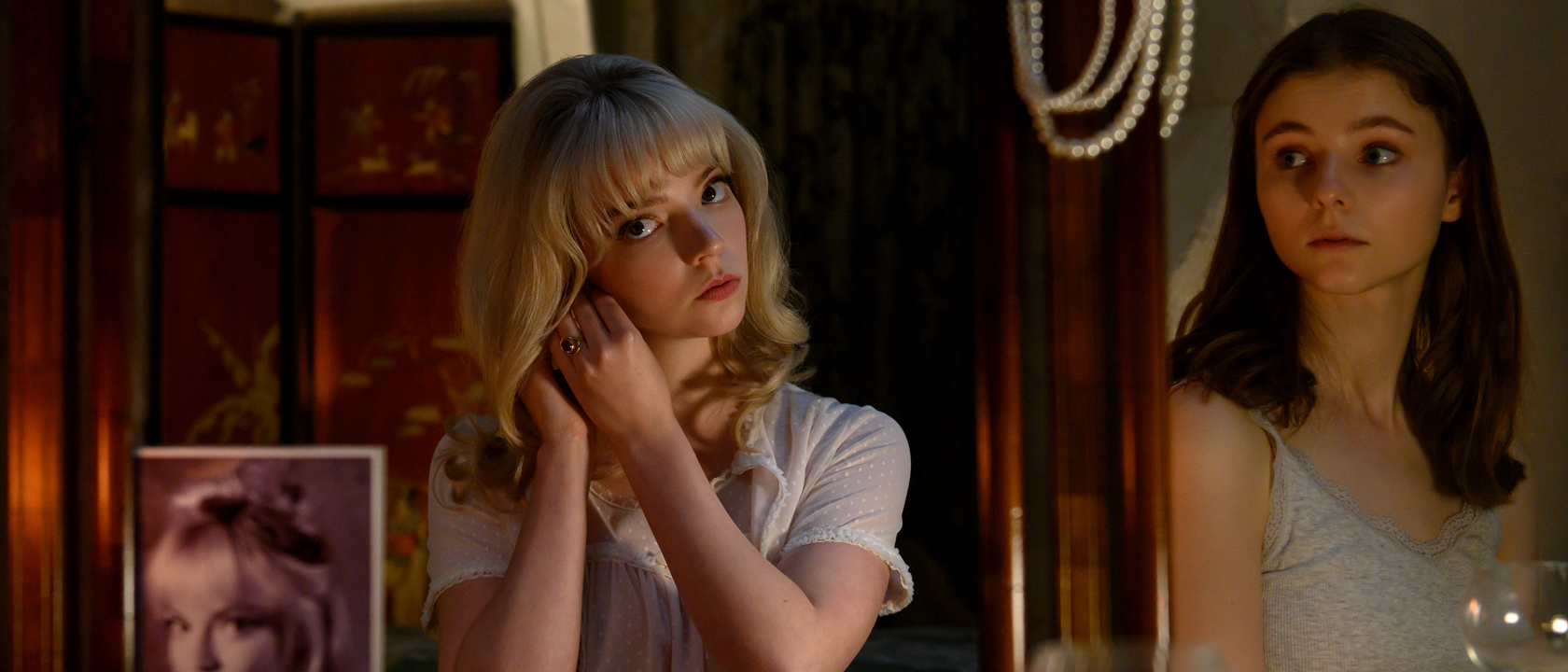Edgar Wright is a phenomenally exciting filmmaker. It’s not just that the movies he makes are of a high quality; he has a dedication to telling new kinds of stories every time out, and is always experimenting with daring and stylish techniques in his direction. Every project has its own surprises and special wow factor.
These are all things that Wright’s fans have known for many years now – but there has been even more reason to be excited for what he would do next in the wake of 2017’s Baby Driver: his first bona fide box office hit. What would he do with the freedom and resources awarded him by success? The answer is Last Night In Soho, which, while flawed, is a film that is filled with fantastic passion and spirit, and succeeds in being one of the writer/director’s most ambitious works to date.
Co-written by Edgar Wright and 1917’s Krysty Wilson-Cairns, Last Night In Soho begins as young Eloise Turner (Thomasin McKenzie) gets the potentially life-changing news that she has been accepted at a fashion school in London. She has big dreams about being a designer, and acceptance puts her on that path – though her grandmother (Rita Tushingham) has concerns about her living in the city given that she is a sensitive person and has a history with mental health issues.
Eloise’s own anticipation for the experience is hampered when she arrives on the campus and almost instantly finds herself wilting around her roommate, Jocasta (Synnøve Karlsen), who is very much of the “mean girl” brand. Her introverted personality clashing with Jocasta’s lifestyle, the protagonist opts to find a place off-campus to live, and she succeeds when she discovers a room to rent in a house in the titular district owned by a sweet-but-strict woman named Ms. Collins (Diana Rigg). She forbids smoking, boys, and night laundry, and demands two month’s rent and a two month deposit – but the innocent teenager is a model tenant.
It’s while staying in the room, however, that Eloise begins to have dreams so vivid that they appear real. At night, her mind travels back to Soho in the 1960s and she experiences the world through the eyes of a young woman named Sandie (Anya Taylor-Joy), who has aspirations to become a singing sensation. Already obsessed with the era thanks to influence from her deceased mother, Eloise is utterly enchanted by the literal woman of her dreams, and starts to take great inspiration from her in her waking life – but as the visions of Sandie take a darker turn, the fashion student finds her nightmares becoming reality.
Last Night In Soho delivers a great twisty, horrific mystery.
While Edgar Wright clearly has a demonstrated love for comedy, action, and science-fiction, as seen in his body of work, horror elements can be found in nearly all of his films, and his wonderful passion for the genre comes through spectacularly in Last Night In Soho. He blends details from across the spectrum – from Italian giallo to Stephen King – and pulls off excellent visual scares where your emotional reaction in large part comes from your appreciation of the characters.
It’s packed with surprises and is very mystery-driven in its plotting (don’t let anyone dare spoil the ending for you), and succeeds in feeding the audience just enough information to maintain curiosity without giving away the game. You should damper expectations for the finale a tad bit, as you’re best not left waiting for something earth-shattering and genre-changing (which Last Night In Soho doesn’t fully provide), but when it does pull the cord, movie-goers are still in for a treat.
Edgar Wright’s awesome direction in Last Night In Soho will repeatedly have you saying, “How did he do that?”
Only serving to enhance the story being told is the technical wizardry that is executed in bringing the film to life. The big showstopper is a sequence that sees Sandie enter and move through a nightclub in one long, sweeping shot, Eloise appearing as her reflection in mirrors and occasionally also swapping places with her. It’s so amazing that it admittedly takes you out of the movie for a moment, as you ponder the mechanics of how the effect is done, but this mental break is more than earned by what’s cinematically achieved.
It’s not work that is quite on the level of the music-synchronized genius of Baby Driver, as the scope of the ambition in the effort just isn’t the same – but it makes Last Night In Soho no less impressive to behold. And like all of Edgar Wright’s films, it seems all but guaranteed to grow more impressive to watch with subsequent viewings, as knowing the full path of the movie will unveil details not perceptible to those not looking for them and only further demonstrate the filmmakers special eye for specifics.
Thomasin McKenzie and Anya Taylor-Joy are both magnetic and brilliant in Last Night In Soho.
In addition to all of the other aspects of Last Night In Soho that differentiate it from Edgar Wright’s previous work, the film also marks the first time that he has worked without a male lead character, and that proves absolutely no obstacle – as the story is not only able to realistically and effectively utilize themes that come directing from the female perspective, but it features two remarkable turns from Thomasin McKenzie and Anya Taylor-Joy.
It’s stunning to watch the two actors perform in parallel playing perfectly contrasting personalities, and both dazzle with their independent evolutions. Playing Sandie, Anya Taylor-Joy once again demonstrates spectacular “born to be a star” screen presence, and it is really everything that the role needs, as Eloise is just as struck by her as we are. The protagonist is inspired by her visions to become bolder in her outlook and personality, and it’s not only awesome to see McKenzie play that arc, but things get even crazier as the narrative gets deeper and deeper into the horror of it all.
While it’s typically a bummer when Halloween lands on a Sunday, it’s advantageous for Last Night In Soho, as it’s a film to check out on opening night, and then immediately go and see again during the holiday – enhancing your appreciation of everything it has to offer. It’s another big when for Edgar Wright, who continues to prove himself as one of the most special talents currently making movies.

Eric Eisenberg is the Assistant Managing Editor at CinemaBlend. After graduating Boston University and earning a bachelor’s degree in journalism, he took a part-time job as a staff writer for CinemaBlend, and after six months was offered the opportunity to move to Los Angeles and take on a newly created West Coast Editor position. Over a decade later, he's continuing to advance his interests and expertise. In addition to conducting filmmaker interviews and contributing to the news and feature content of the site, Eric also oversees the Movie Reviews section, writes the the weekend box office report (published Sundays), and is the site's resident Stephen King expert. He has two King-related columns.











